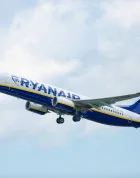Forget the Flames and Oilers, there’s a new Battle of Alberta in town.
It looks like Calgary and my adoptive home of Edmonton are locked in a race between our ultra-low-cost carrier airlines, instead of between our venerable hockey times.
Calgary-based Lynx Air and Edmonton-based Flair Airlines are both massively expanding their fleets and serviced routes in 2023, and your pocketbook might stand to benefit. With record delays at airports this past summer, will the savings be worth the potential suffering? Let’s find out!
New Routes at Flair and Lynx
First up is Flair Airlines, which calls Edmonton International Airport home. Flair intends to acquire seven new aircraft by summer of 2023, which the airline would use to expand operations by a full 50%.
This is exceptionally ambitious for an airline that was, until recently, undergoing some tough questions about its ownership structure.

Regardless, Flair is rebounding with a vengeance, and it intends to increase its fleet size to a total of 27 planes by adding seven more Boeing 737 MAX 8 aircraft. This move indicates the airline’s confidence is unshaken, even after the chaotic summer of 2022’s travel woes.
The airline has also indicated that there will be an additional 10 flights between on its Toronto–Calgary and Vancouver–Toronto routes, as well as increases to its service to Deer Lake, Nashville, and Mexico.
On the other hand is Calgary-based Lynx Air, which made its first flight back in April 2022. The company has placed plenty of aircraft on order, and now feels confident enough to launch four new routes to the United States:
- Toronto–Orlando, four times per week, beginning January 23, 2023
- Calgary–Phoenix, three times per week, beginning February 7, 2023
- Calgary–Los Angeles, three times per week, beginning February 16, 2023
- Calgary–Las Vegas, four times per week, beginning February 24, 2023
These are some of the hottest destinations (in both temperature and desirability) for tourists and snowbirds alike, and will certainly make for a welcoming escape from the clutches of the Canadian winter. To sweeten the deal, Lynx has also released a contest, in which one can enter for a chance to win one of four trips to the United States.
As of yet, there’s been no response from Canada’s larger, more established budget carrier: Swoop. It’s hard to imagine them resting on their laurels while Lynx and Flair expand so aggressively.
If demand keeps rising for ultra-low-cost flying, we might even see prices race to the bottom in the future – which makes forgoing benefits from having Aeroplan Elite Status when paying cash much less painful.
Ultra-Low-Cost Carriers: The Way of the Future?
The ultra-low-cost carrier business model is one with which most of us are well-acquainted, although this familiarity cannot be always be said to be the fondest. The experience of boarding a packed, no-frills flight with only a small personal item – because carry-ons incur extra fees – is matched by the bare-bones nature of the service.
In-flight meals, entertainment systems, beverages, and oftentimes (sadly enough) human kindness come at a premium. Most budget airlines, from Lynx to Flair all the way to newer ones such as the upstart Canada Jetlines, keep prices low by offering you no amenities.
However, I can’t say I’m surprised.
In recent years, we’ve seen “shrinkflation” happen with the rising costs of airline transportation services, especially for economy class passengers. With this phenomenon, passengers pay more for less, which is often described as services offered on flights being “streamlined”.
Indeed, products such as Air Canada Rouge are often lacklustre at best. What’s more, is that it costs the same amount of money as its name-brand cousin, while the low-cost subsidiary has service much more reminiscent of Flair.

Therefore, it makes logical sense that cheaper airlines, which make no claims of being a remotely luxurious product, creep into the space to undercut the big companies on price and build a more loyal customer base. After all, no one really needs a lie-flat seat on a three-hour domestic flight.
But will this strategy survive the test of time?
This past summer makes me feel that the constant flight delays experienced by customers might be good for the ultra-low-cost crew, but not for the best reasons.
While customers might divert their hard-earned money to cheaper airlines, it seems like it’s because of a quiet resignation on their part that carriers don’t feel committed to making their scheduled times. What’s more, compliance with the Air Passenger Protection Regulations is going to remain questionable at best, especially with a lack of enforcement from government bodies.
While this may be good for the revenue of Flair and Lynx, it represents a loss of trust in the aviation industry on the part of consumers. I hope that the expansion of these airlines’ fleets and destinations will be matched with a commitment to providing customers with reliable transportation.
Conclusion
It’s exciting to see another Battle of Alberta, and not just in winter sports. I wish Flair and Lynx the best of luck in expanding their routes and customer bases.
This comes with the caveat that they should be respectful of customers’ time. If flights are free of complimentary food and soda, then they should, at a bare minimum, depart and land on time.
Here’s hoping that we have not seen the end of competition in the Canadian aviation space. Until next time, pack your neck pillows.















